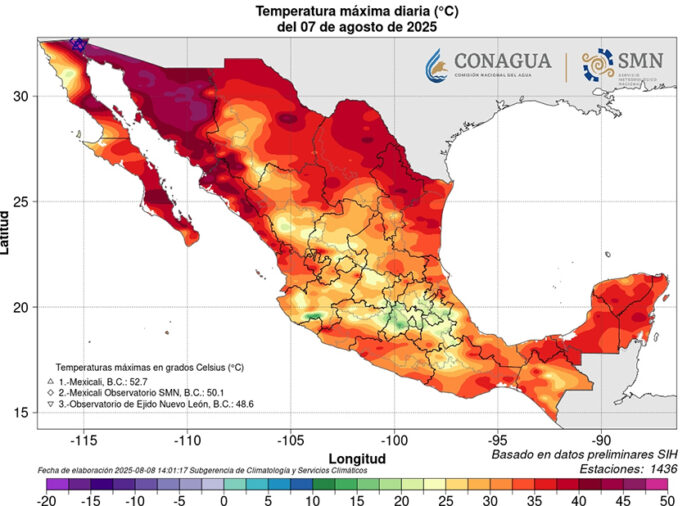Prompted by adverse climatic conditions across several regions of the nation, Mexico’s National Meteorological Service (SMN) has issued warnings of a range of weather-related threats from life-threatening surf, high winds and monsoon-related intense rainfall to a scorching heat wave that’s sent temperatures well above 40 degrees C (100 degrees F).
In the Pacific Ocean, Tropical Storm Ivo continued to generate surf swells affecting Mexico’s southwestern coast on Friday and the storm’s maximum sustained winds of 96 km/h (60 mph) began to reach the southern Baja California Peninsula.
#AvisoMeteorológico.#Ivo mantendrá #Lluvias fuertes en el sur de #BajaCaliforniaSur mientras se aleja gradualmente de las costas de #México.
Más información enhttps://t.co/fqyGbgRy5P pic.twitter.com/IiEzbftMdt
— CONAGUA Clima (@conagua_clima) August 8, 2025
The U.S. National Hurricane Center (NHC) also issued an advisory on Friday, warning that the swells were causing dangerous surf and rip-current conditions. Separately, the SMN warned that Baja California Sur could see surf swells up to 4 meters (13 feet) high, while Oaxaca and Chiapas could expect swells of up to 3 meters (10 feet).
The SMN also warned coastal residents of the states of Jalisco, Nayarit, Colima and Baja California Sur of heavy rains and high winds. The SMN said Jalisco could see upwards of 75 mm (3 inches) of rain on Friday and urged residents in affected areas to pay heed to advisories issued by local civil protection services.
At the same time, a heat wave was scorching northwestern Mexico. Mexicali, the capital of Baja California, set a new record high temperature on Thursday, when the mercury topped out at a potentially lethal 52.7 degrees C (127 degrees F).
State and local authorities in the region have implemented measures to mitigate the heat, setting up hydration stations and air-conditioned shelters.
A report on this year’s heat waves issued on Aug. 1 by Mexico’s General Directorate of Epidemiology said extreme temperatures were to blame for 49 deaths through the end of July, including three in Baja California and 14 in neighboring Sonora.
A third meteorological phenomenon, the Mexican monsoon, was causing atmospheric instability and generating intense rains in the northern states of Durango and Sinaloa.
The Mexican monsoon is a seasonal weather pattern featuring a shift in wind and precipitation patterns characterized by warm, moist air moving inland from the Atlantic and Pacific oceans. The monsoon converges in northwestern Mexico, bringing significant rainfall.
The SMN said the monsoon could dump up to 75 mm (3 inches) of rain in Durango and Sinaloa, while Jalisco is expected to see considerable precipitation. Electrical storms and hail were also in the forecast.
With reports from La Voz de la Frontera, Informador and Debate
